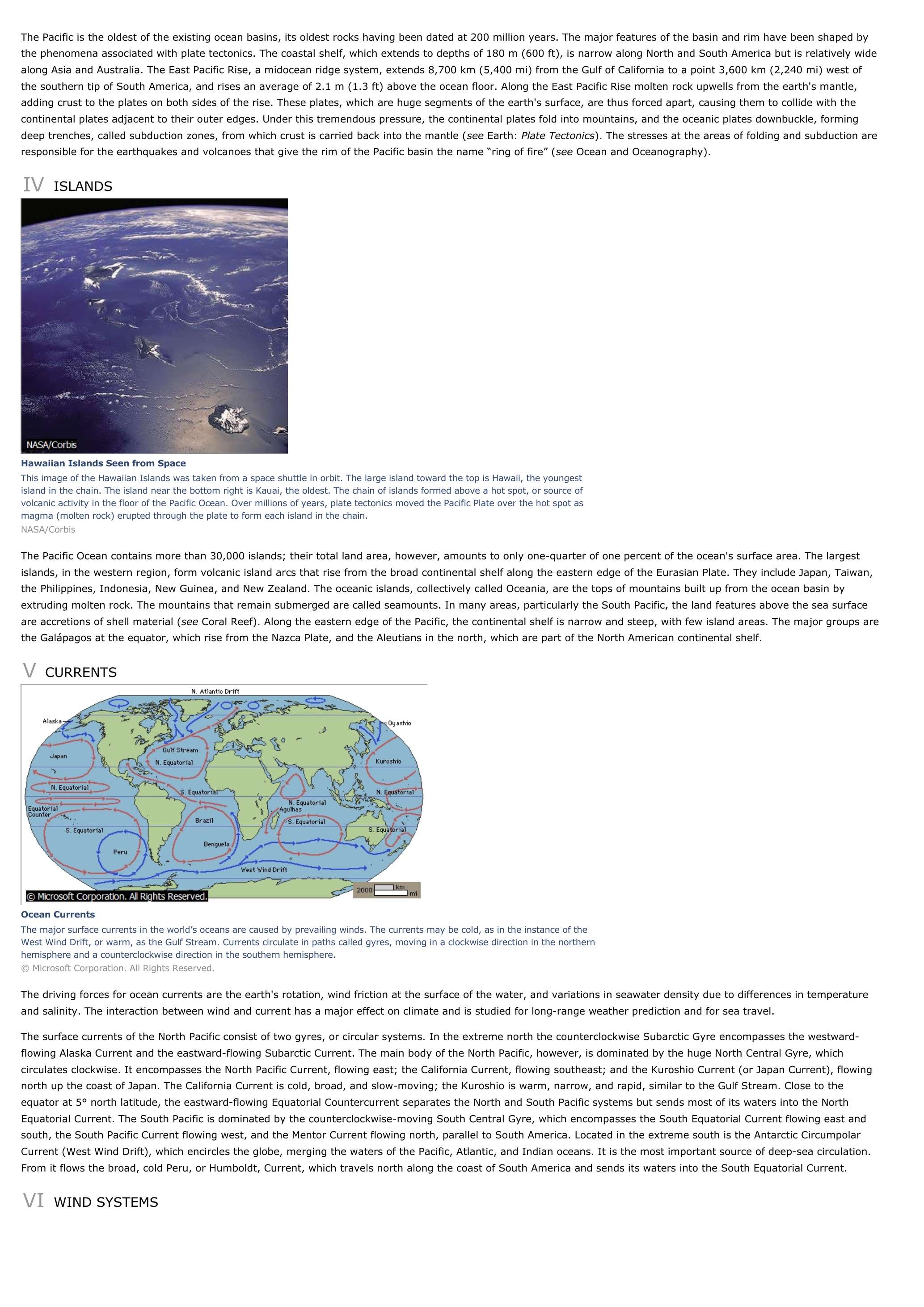Pacific Ocean - geography.
Publié le 26/05/2013

Extrait du document
«
The Pacific is the oldest of the existing ocean basins, its oldest rocks having been dated at 200 million years.
The major features of the basin and rim have been shaped bythe phenomena associated with plate tectonics.
The coastal shelf, which extends to depths of 180 m (600 ft), is narrow along North and South America but is relatively widealong Asia and Australia.
The East Pacific Rise, a midocean ridge system, extends 8,700 km (5,400 mi) from the Gulf of California to a point 3,600 km (2,240 mi) west ofthe southern tip of South America, and rises an average of 2.1 m (1.3 ft) above the ocean floor.
Along the East Pacific Rise molten rock upwells from the earth's mantle,adding crust to the plates on both sides of the rise.
These plates, which are huge segments of the earth's surface, are thus forced apart, causing them to collide with thecontinental plates adjacent to their outer edges.
Under this tremendous pressure, the continental plates fold into mountains, and the oceanic plates downbuckle, formingdeep trenches, called subduction zones, from which crust is carried back into the mantle ( see Earth: Plate Tectonics ).
The stresses at the areas of folding and subduction are responsible for the earthquakes and volcanoes that give the rim of the Pacific basin the name “ring of fire” ( see Ocean and Oceanography).
IV ISLANDS
Hawaiian Islands Seen from SpaceThis image of the Hawaiian Islands was taken from a space shuttle in orbit.
The large island toward the top is Hawaii, the youngestisland in the chain.
The island near the bottom right is Kauai, the oldest.
The chain of islands formed above a hot spot, or source ofvolcanic activity in the floor of the Pacific Ocean.
Over millions of years, plate tectonics moved the Pacific Plate over the hot spot asmagma (molten rock) erupted through the plate to form each island in the chain.NASA/Corbis
The Pacific Ocean contains more than 30,000 islands; their total land area, however, amounts to only one-quarter of one percent of the ocean's surface area.
The largestislands, in the western region, form volcanic island arcs that rise from the broad continental shelf along the eastern edge of the Eurasian Plate.
They include Japan, Taiwan,the Philippines, Indonesia, New Guinea, and New Zealand.
The oceanic islands, collectively called Oceania, are the tops of mountains built up from the ocean basin byextruding molten rock.
The mountains that remain submerged are called seamounts.
In many areas, particularly the South Pacific, the land features above the sea surfaceare accretions of shell material ( see Coral Reef).
Along the eastern edge of the Pacific, the continental shelf is narrow and steep, with few island areas.
The major groups are the Galápagos at the equator, which rise from the Nazca Plate, and the Aleutians in the north, which are part of the North American continental shelf.
V CURRENTS
Ocean CurrentsThe major surface currents in the world’s oceans are caused by prevailing winds.
The currents may be cold, as in the instance of theWest Wind Drift, or warm, as the Gulf Stream.
Currents circulate in paths called gyres, moving in a clockwise direction in the northernhemisphere and a counterclockwise direction in the southern hemisphere.© Microsoft Corporation.
All Rights Reserved.
The driving forces for ocean currents are the earth's rotation, wind friction at the surface of the water, and variations in seawater density due to differences in temperatureand salinity.
The interaction between wind and current has a major effect on climate and is studied for long-range weather prediction and for sea travel.
The surface currents of the North Pacific consist of two gyres, or circular systems.
In the extreme north the counterclockwise Subarctic Gyre encompasses the westward-flowing Alaska Current and the eastward-flowing Subarctic Current.
The main body of the North Pacific, however, is dominated by the huge North Central Gyre, whichcirculates clockwise.
It encompasses the North Pacific Current, flowing east; the California Current, flowing southeast; and the Kuroshio Current (or Japan Current), flowingnorth up the coast of Japan.
The California Current is cold, broad, and slow-moving; the Kuroshio is warm, narrow, and rapid, similar to the Gulf Stream.
Close to theequator at 5° north latitude, the eastward-flowing Equatorial Countercurrent separates the North and South Pacific systems but sends most of its waters into the NorthEquatorial Current.
The South Pacific is dominated by the counterclockwise-moving South Central Gyre, which encompasses the South Equatorial Current flowing east andsouth, the South Pacific Current flowing west, and the Mentor Current flowing north, parallel to South America.
Located in the extreme south is the Antarctic CircumpolarCurrent (West Wind Drift), which encircles the globe, merging the waters of the Pacific, Atlantic, and Indian oceans.
It is the most important source of deep-sea circulation.From it flows the broad, cold Peru, or Humboldt, Current, which travels north along the coast of South America and sends its waters into the South Equatorial Current.
VI WIND SYSTEMS.
»
↓↓↓ APERÇU DU DOCUMENT ↓↓↓
Liens utiles
- Pacific Ocean - Geography.
- Arctic Ocean - Geography.
- Atlantic Ocean - Geography.
- Indian Ocean - Geography.
- Ocean and Oceanography - Geography.

































